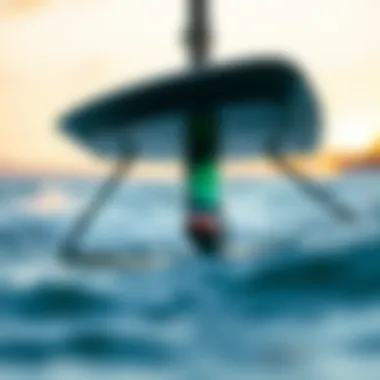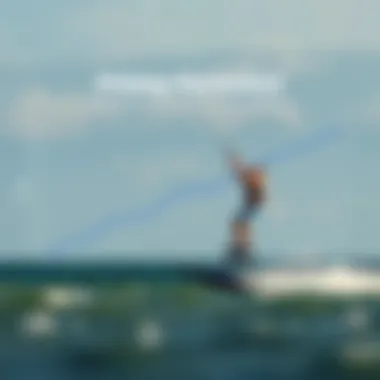Exploring the Factors Behind Electric Hydrofoil Prices


Intro
Electric hydrofoils have made waves in the watersports world, presenting a thrilling mix of technology and nature. The increasing interest in this innovative mode of aquatic travel has sparked curiosity not just in its operation but also in its pricing dynamics. Understanding the factors that affect electric hydrofoil prices is crucial for anyone contemplating a purchase.
The market for these watercraft is a reflection of emerging technology, consumer demand, and diverse options available today. Pricing is not merely a number chalked on a price tag; it encompasses a myriad of influences, from manufacturing costs and brand reputation to performance features and market trends. Whether you're a seasoned waterman or a newcomer eager to take to the waves, knowing what to expect goes a long way in making informed decisions.
In this thorough examination, we will peel back the layers of what drives pricing in the electric hydrofoil arena. We’ll dissect the advantages and disadvantages of investing in one of these machines, helping potential buyers assess whether the financial commitment aligns with their adventure aspirations. With a clearer understanding of the current market landscape, enthusiasts can ensure they are not just buying a product but are investing in a gratifying experience.
Let's embark on this analysis and equip you with the knowledge to navigate the waters of electric hydrofoil purchasing.
Market Overview
Understanding the market dynamics surrounding electric hydrofoils is pivotal for anyone keen on venturing into this innovative niche. The electric hydrofoil market is not merely about purchasing a product; it encompasses broader trends that reflect technological advancements, consumer preferences, and variations in manufacturing practices. Grasping these aspects helps potential buyers make informed decisions, aligning their choices with their budget and intended usage.
Electric hydrofoils have surged in popularity over the last few years, driven by a shift toward more sustainable outdoor activities. As many people are increasingly conscious of environmental impacts, the market has responded accordingly. Buyers are not just looking for a fun time on the water; they are also considering the ecological footprint of their equipment.
Current Trends in Electric Hydrofoil Prices
The price of electric hydrofoils can vary significantly based on several factors. In recent years, a noticeable trend has emerged: the cost of entry-level models is becoming more accessible, drawing in newcomers who might have skipped this sport before due to high prices. Models once priced in the realm of extravagant luxury have transitioned toward more affordable ranges, thus democratizing access to this exhilarating sport. However, it is essential to recognize that while the base prices may seem amiable, there are also higher-end models that continue to command premium prices due to enhanced features and better materials.
Factors contributing to these pricing trends include:
- Technological Advancements: Manufacturers are incorporating better battery technology, offering longer run times and shorter charging times. These advancements come at a cost, often reflected in the price tag.
- Increased Competition: As more companies enter the electric hydrofoil market, there's a variance in pricing strategies. This competition can lead to price drops as brands find ways to differentiate themselves.
Comparative Analysis with Other Water Sports Equipment
When juxtaposing electric hydrofoils with other types of water sports gear, such as traditional surfboards or jet skis, several key differences arise. Electric hydrofoils stand out by providing a unique riding experience that combines elements of surfing and flying above the water's surface.
In comparison with similar products:
- Jet Skis: These can be quite costly, often starting from several thousand dollars. Furthermore, they demand ongoing maintenance and fuel costs. Hydrofoils, while initially priced competitively, usually offer lower ongoing expenses due to electric-powered operations.
- Surfboards: Traditional surfboards are typically the most affordable option, but they don't provide the exhilarating "flying" sensation that comes with hydrofoils. Their price point usually reflects simpler manufacturing and minimal technology. However, as customization options for surfboards increase, some high-end boards may rival entry-level hydrofoils in price.
The bottom line here is that the electric hydrofoil prices do seem steep at first glance, yet they start making sense when one considers the technology integrated into the design, the thrilling experience they provide, and the longer-term cost benefits compared to more traditional water sports equipment.
"Jumping into the electric hydrofoil experience feels like taking a leap into the future of water sports."
In sum, understanding the present trends in electric hydrofoil pricing sheds light on broader market dynamics, helping buyers to set realistic expectations and make informed choices.
Key Factors Affecting Pricing
Understanding the price of electric hydrofoils requires a closer look at several key factors. These elements not only shape the overall cost but also impact the buyer's decision-making process. Factors like material quality, technological innovations, and brand reputations play critical roles. A thorough examination of these aspects helps potential buyers weigh their options wisely and make informed purchases that align with their needs.
Material Quality and Construction
When diving into the world of electric hydrofoils, the materials used in their construction significantly influence their price. High-quality materials such as carbon fiber and advanced alloys not only enhance durability but also contribute to performance and safety. For instance, a hydrofoil made with lightweight carbon fiber can allow for better maneuverability and speed, justifying a higher sticker price.
In contrast, models constructed with lower-grade materials, while more budget-friendly, might compromise on performance over time. Therefore, buyers should assess the construction details. Are the joints reinforced? Is the board designed for saltwater condition? Understanding these elements arms purchasers with insights about long-term investment versus initial cost.
"A wise buyer doesn’t just look at the price tag; they look beyond it to what each product will deliver in the long run."


Key Points to Consider:
- Material Types: Carbon fiber is often used for premium models due to its lightweight and strength.
- Durability: Higher quality materials typically offer better resistance against wear and tear, especially in harsh marine environments.
- Construction Techniques: Handcrafted or advanced construction methodologies can lead to higher costs but often result in superior products.
Technology and Features
Electric hydrofoils come packed with cutting-edge technology, which can significantly influence pricing. Features such as battery capacity, motor efficiency, and control systems are crucial benchmarks for distinguishing models. High-performing hydrofoils usually feature sophisticated electric motors that provide greater thrust, enabling users to glide over the water with ease.
Additionally, integrated smart technology has become a norm, allowing riders to track their speed, battery life, and other metrics via smartphone apps. These conveniences, while boosting user experience, also contribute to increased prices. It’s essential for potential buyers to recognize whether they need the latest technology or would benefit more from a simpler, reliable model.
Considerations for Potential Buyers:
- Motor Type: Brushless motors tend to be more efficient and offer longer life spans.
- Battery Details: Lithium-ion batteries can be costly but often provide superior performance compared to lead-acid alternatives.
- Additional Features: Smart controls and increased battery analytics might appeal to tech-savvy users but can also elevate the cost.
Brand Reputation and Market Positioning
The brand behind an electric hydrofoil often adds a layer of complexity when considering pricing. Established brands like Lift Foils and Takuma have built reputations over the years, creating trust among consumers. Their prices often reflect this reputation, as buyers feel more secure investing in reliable brands known for quality and performance.
On the other hand, newer companies might offer competitive prices to capture market share, yet they may not have a proven track record. Evaluating brand history, customer reviews, and warranty offerings can provide insights into whether a brand is worth the premium they demand.
Important Factors Related to Brand Reputation:
- Customer Reviews: Checking platforms like Reddit or specialty forums can shed light on real experiences.
- Customer Service: Established brands often provide better post-purchase support and warranty options.
- Reputation in the Market: Well-regarded brands typically offer better resale values and longevity in their products.
Ultimately, the interplay of material quality, technology, and brand reputation creates a comprehensive picture affecting electric hydrofoil prices. Savvy buyers will take these factors into account, resulting in informed and satisfying purchases.
Segments of the Market
Understanding the market segments for electric hydrofoils is essential for anyone considering a purchase. Different segments cater to varying needs, preferences, and budgets, allowing buyers to find the right fit. This analysis not only highlights the diversity in design and functionality but also offers clues about pricing. Overall, knowing where a hydrofoil fits in the market spectrum can help buyers make informed decisions and understand what kind of return on investment they can expect.
Entry-Level Electric Hydrofoils
Entry-level electric hydrofoils are often seen as the gateway for newcomers to the world of hydrofoiling. These models typically attract individuals who may not have extensive experience with watersports but still seek a taste of the thrill. Generally priced lower than more advanced options, entry-level hydrofoils prioritize ease of use, stability, and adequate performance while also being wallet-friendly.
Many entry-level models feature simplified controls and design, which are great for beginners who are still honing their skills. For instance, brands like Radinn and Lift offer options with uncomplicated assembly, making it easy for users to get started right away without feeling too overwhelmed.
- Benefits:
- Affordable pricing, often ranging from $3,000 to $5,000.
- User-friendly design enhances learning curve.
- Lightweight materials enable easier transportation.
Choosing an entry-level hydrofoil means starting on the right foot without diving too deep into your pockets. However, it’s worth noting that while these options provide decent performance, they may not hold up as well in terms of resale value compared to advanced models.
Mid-Range Options
Mid-range electric hydrofoils serve a sweet spot in the market, where functionality meets value for money. Typically ranging from $5,000 to $10,000, these hydrofoils appeal to enthusiasts ready to take the next step, offering a solid mix of performance and durability. Mid-range models often incorporate improved technology and features compared to their entry-level counterparts.
For example, the Zieman Hydrofoil provides a stable ride, enhanced battery life, and customizable settings that allow riders to tailor their experience. These models are often made using higher-quality materials, resulting in better construction and, consequently, longer lifespans. Consumers can expect smoother performance and more robust support from brands in this segment.
- Benefits:
- Enhanced performance suitable for intermediate riders.
- Greater focus on durability and range.
- More technological features, such as improved battery management.


While mid-range electric hydrofoils do come with a higher price tag, they offer better value for those who plan on using them frequently or progressing in their skills. In essence, these models are not just purchases; they can be seen as investments towards enhanced performance.
High-End Hydrofoils
High-end electric hydrofoils are the pinnacle of design and performance, often catering to serious riders who demand the best. These models can command prices from $10,000 upwards to $20,000 or more, reflecting their advanced features and high-quality materials. Buyers in this segment are generally experienced and know exactly what they want from their hydrofoil experiences.
Take, for instance, the Lift eFoil, renowned for its sophisticated design and unparalleled riding experience. These models often boast features like powerful motors, advanced battery systems, and exceptional stability, making them a worthwhile investment for dedicated enthusiasts or professionals.
- Benefits:
- Premium features enhance riding experience.
- Top-tier performance suited for both professionals and advanced users.
- High resale value due to brand recognition and demand.
High-end hydrofoils often come with not just performance but also prestige. As more experienced riders invest in such models, they can expect not only satisfaction in usage but also good resale prospects if they choose to upgrade in the future.
Cost Breakdown
Understanding the cost breakdown of electric hydrofoils is crucial for prospective buyers. It's not just about the sticker price; a host of factors play into what you end up paying once you decide to invest in one of these watercraft. A clear grasp of both expected costs and potential hidden expenses prepares you to make an informed decision. After all, no one wants to be caught off guard by unexpected financial burdens that can arise after the purchase.
Price Range Overview
Electric hydrofoils can vary significantly in price depending on their features, quality, and brand. On the entry-level end, prices might start around $3,000, which typically gets you a basic model suited for learners or occasional riders. Moving up to mid-range options, expect to pay between $6,000 to $10,000. These usually come with more advanced features and better materials, offering a smoother experience on the water. High-end hydrofoils can soar to $15,000 or even $20,000, often boasting superior build quality, cutting-edge technology, and enhanced performance capabilities.
- Entry-Level: Starting at around $3,000, these models are fit for beginners.
- Mid-Range: Generally priced between $6,000 and $10,000, suitable for those who have some experience.
- High-End: These can range from $15,000 to $20,000 or more, featuring top-tier performance and features.
While these figures give a general idea, actual prices can vary by retailer, location, and availability. Price comparisons across various platforms—whether online or through specialty stores—can help ensure you're not paying a premium unnecessarily.
Hidden Costs and Additional Expenses
When budgeting for an electric hydrofoil, it's imperative to consider additional costs that often slip through the cracks. Some of these expenses might seem trivial at first glance but can accumulate swiftly.
Here are some common hidden costs:
- Accessories: Things like helmets, life jackets, and other essential gear shouldn't be overlooked. They could add around $200 to $500 to your overall bill for quality items.
- Maintenance: Regular upkeep is vital for longevity. Maintenance costs may range between $100 to $300 annually, depending on usage and conditions.
- Insurance: Some riders prefer to insure their hydrofoil for peace of mind. This could add another $100-$300 per year.
- Transport Costs: Depending on where you live, you might need a dedicated trailer or vehicle modifications to transport your hydrofoil safely, which can cost anywhere from $500 to $2,000.
“An informed buyer is a savvy buyer. Understanding not just the upfront cost but also the hidden expenses can save you a pretty penny in the long run.”
Taking the time to factor in these elements when considering your budget will not only give you a more accurate depiction of what your investment entails but also empower you to make a choice that aligns with your financial considerations and lifestyle. In essence, knowing the cost breakdown can transform an enthusiastic purchase into a well-calculated decision.
Comparative Pricing Analysis
Grappling with the price of electric hydrofoils is like deciphering a puzzle; it requires insights from various angles. Understanding the comparative pricing analysis for electric hydrofoils aids potential buyers in identifying their best options and making informed decisions. This analysis provides clarity on how local and international markets position these products, what influences pricing across regions, and how different retail environments impact final costs.
The intricacies of pricing models give a real edge. Knowing how to navigate local market dynamics versus the backdrop of the international arena allows buyers to maximize their investment. This section will break down those complexities, offering comparisons that underscore why prices might differ not only by brand but by geographic area.
Local Market Vs. International Market Pricing
One of the main considerations in pricing analysis is how local market conditions contrast with international pricing structures. Typically, products like electric hydrofoils can see wide price variations across borders.
For instance, while you might find a certain model in the United States for around $3,500, the same model could be listed for €3,200 in Europe. Factors influencing these discrepancies include:
- Import and Export Tariffs: Different countries impose varying taxes or fees on international goods, which can significantly raise prices.
- Local Demand and Supply Dynamics: In areas where electric hydrofoils are becoming trendy, sellers might increase prices due to higher demand.
- Currency Fluctuations: Exchange rates can play a subtle yet impactful role in the overall pricing strategy for international buyers.


"Understanding your local pricing environment helps not just in savings, but also in determining the best features for your money."
Online Retailers vs. Specialty Stores
The choice between online retailers and specialty stores also plays a crucial role in price considerations.
Online marketplaces, like eBay and Amazon, often offer competitive pricing on electric hydrofoils, benefiting from economies of scale and lower overhead costs. However, buyers may face:
- Risks with Quality and Authenticity: Uncertainties about the reliability of the seller can lead to issues with product quality.
- Limited Customer Support: Immediate assistance with product queries or issues may not be available when purchasing online.
Contrastingly, specialty stores provide a tactile experience, enabling customers to see and possibly test the hydrofoil before they buy. Factors at play with these stores often include:
- Higher Prices for Personalized Service: The overhead costs associated with bricks-and-mortar locations can inflate prices.
- Expert Guidance: Having knowledgeable staff to explain nuances can be invaluable for first-time buyers.
Value for Money
When considering the purchase of an electric hydrofoil, the concept of value for money emerges as a critical factor. It goes beyond just the initial price tag slapped on the equipment; it encompasses a broader perspective, factoring in durability, performance, potential resale, and overall experience.
Investing in an electric hydrofoil is akin to playing chess. Just as a seasoned player contemplates their moves ahead of time, prospective buyers should scrutinize their choices, aiming to ensure they’re not just scoring a cheap deal but rather investing in a product that will serve them well in the long run.
Long-Term Investment Considerations
Electric hydrofoils can be a substantial investment, and understanding their long-term potential is vital. Several considerations come into play:
- Durability and Materials: Hydrofoils constructed with high-quality materials, such as carbon fiber, tend to stand the test of time. Over the years, this durability translates into fewer repairs or replacements, saving money down the line.
- Technological Adaptability: With rapid advancements in technology, many models are designed to be upgradeable. Opting for a hydrofoil that allows modifications can prolong its relevance, ensuring it's not quickly outdated.
- Maintenance Costs: Regular upkeep is essential in extending a hydrofoil’s life. Although high-quality equipment may come with a steep upfront cost, lower maintenance needs and durability can often lower overall expense.
Investors in electric hydrofoils should deliberate the long-term implications of their purchase rather than getting lured by attractive discounts or attractive features that don’t guarantee sustained performance.
"The best investment is the one that pays dividends in enjoyment and quality over time."
Resale Value and Market Demand
Understanding the resale landscape is equally essential for those looking at electric hydrofoils. A few critical elements factor into this:
- Brand Reputation: Hydrofoils from reputable brands commonly retain their value better. Recognizable names typically inspire confidence in quality and performance, enticing second-hand buyers.
- Market Trends: Just like fashion, the popularity of specific hydrofoil models comes and goes. Staying informed about what’s in vogue can help determine future resale potential. Following forums like Reddit can provide insights into current trends.
- Community Demand: The electric hydrofoil community is growing. Engaging with outdoor enthusiasts or participating in local meetups can boost awareness of one's resale item. A robust community means a potentially high interest in acquiring pre-owned models.
Future of Electric Hydrofoils
The future of electric hydrofoils holds significant promise, capturing the attention of both enthusiasts and industry stakeholders alike. As the popularity of this innovative watercraft grows, so too does the need to understand the driving forces behind it. Those eyeing options in the electric hydrofoil sector will benefit from grasping the implications of advancements in technology and shifting market dynamics, which could steer the course of pricing and accessibility.
Technological Advancements and Their Potential Impact on Pricing
Technological advancements are reshaping the landscape of electric hydrofoils rapidly. As manufacturers continually refine design elements and integrate superior components, one can expect the price spectrum to reflect these enhancements. Understanding these evolutionary leaps is crucial for potential buyers.
For instance, take battery technology. Developments like solid-state batteries promise longer life spans and reduced charging times—features that can shift prices upwards but also enhance the user experience significantly. If the battery life can extend by hours compared to older models, many might argue it’s worth a few extra dollars. Additionally, features such as improved hydrodynamics through advanced materials not only enhance ride quality but can also justify a steeper price tag.
- Lightweight materials, such as carbon fiber, are becoming more standardized, delivering durability without the bulk, but they also inflate costs.
- Smart technologies, including automated controls and mobile app integrations, can enrich the user experience, leading to potential price increases as these become the norm.
These advancements are not mere bells and whistles—they shape the trajectory of product pricing by shifting consumer expectations. The notion of "paying for innovation" becomes increasingly relevant. If a model guarantees a longer lifespan and better performance, buyers may find themselves more willing to stretch their budgets.
Market Predictions for the Next Few Years
Looking ahead, a few patterns are beginning to crop up among industry experts regarding what the electric hydrofoil market might look like.
- Increased Accessibility: As production scales and technologies simplify manufacturing processes, the long-standing view of electric hydrofoils as luxury items may change. A forecast suggests that entry-level models will become more prevalent, appealing to a broader audience. No longer limited to just the well-heeled, even amateur water sport aficionados could make a splash with more affordable options.
- Sustainability Trends: With the global push for eco-friendly transportation, electric hydrofoils are likely to ride the wave of this momentum. Manufacturers focusing on sustainable practices may lead to increased demand, consequently affecting pricing strategies. Many courses in the market will focus on electric options over fossil fuel counterparts, creating a natural rise in interest and market value.
- Enhancement of Hospitality Experiences: As adventure tourism continues to grow, incorporating electric hydrofoils into rental fleets could become commonplace in scenic destinations. Tour operators may pivot toward including hydrofoil experiences, leading to an uptick in market demand—ultimately affecting prices.
In summary, as electric hydrofoils wade deeper into mainstream consciousness, both technological advancements and market shifts will shape pricing and accessibility. Understanding these elements is essential for anyone considering a purchase, ensuring they stay ahead of the game in this ever-evolving field.















